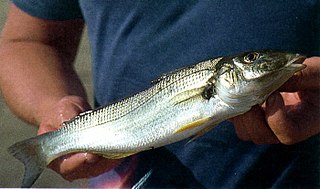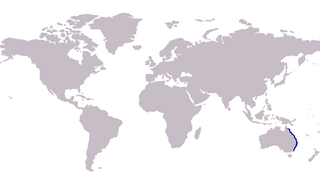
The Lamniformes are an order of sharks commonly known as mackerel sharks. It includes some of the most familiar species of sharks, such as the great white as well as less familiar ones, such as the goblin shark and megamouth shark.

Parrotfish are a group of fish species traditionally regarded as a family (Scaridae), but now often treated as a subfamily (Scarinae) or tribe (Scarini) of the wrasses (Labridae). With roughly 95 species, this group's largest species richness is in the Indo-Pacific. They are found in coral reefs, rocky coasts, and seagrass beds, and can play a significant role in bioerosion.

The sand tiger shark, grey/gray nurse shark, spotted ragged-tooth shark or blue-nurse sand tiger, is a species of shark that inhabits subtropical and temperate waters worldwide. It inhabits the continental shelf, from sandy shorelines and submerged reefs to a depth of around 191 m (627 ft). They dwell in the waters of Japan, Australia, South Africa, and the east coasts of North and South America. The sand tiger shark also inhabited the Mediterranean, however it was last seen there in 2003 and is presumed extinct in the region. Despite its common names, it is not closely related to either the tiger shark or the nurse shark.

Adenanthos is a genus of Australian native shrubs in the flowering plant family Proteaceae. Variable in habit and leaf shape, it is the only genus in the family where solitary flowers are the norm. It was discovered in 1791, and formally published by Jacques Labillardière in 1805. The type species is Adenanthos cuneatus, and 33 species are recognised. The genus is placed in subfamily Proteoideae, and is held to be most closely related to several South African genera.

Ammocrypta is a genus of freshwater ray-finned fish, commonly known as the sand darters, which is classified in the subfamily Etheostomatinae, part of the family Percidae which also includes the perches, ruffes and pikeperches. The species in the genus occur in eastern North America in Canada and the continental United States.

Sillago is a genus of fish in the family Sillaginidae and the only non-monotypic genus in the family. Distinguishing the species can be difficult, with many similar in appearance and colour, forcing the use of swim bladder morphology as a definitive feature. All species are benthic in nature and generally coastal fish, living in shallow, protected waters although there are exceptions. Minor fisheries exist around various species of Sillago, making them of minor importance in most of their range. This genus has the widest distribution of any smelt-whiting genus, spanning much of the Indo-Pacific. The genus ranges from the east coast of Africa to Japan in the east and Southern Australia in the south, with most species concentrated around South East Asia, the Indonesian Archipelago and Australia. Many species have overlapping distribution, often making positive identification hard.

The sand whiting, also known as the summer whiting, yellowfin whiting or blue-nose whiting, is a common species of coastal marine fish of the family Sillaginidae, the smelt-whitings. It is a slender, slightly compressed fish that is very similar to other species of Sillago, with detailed spine, ray and lateral line scale counts needed to distinguish the species between its nearest relative Sillago analis. The sand whiting is distributed along the east coast of Australia from Cape York south to Tasmania, as well as Lord Howe Island and New Caledonia in the Pacific Ocean.

The trumpeter whiting, also known as the winter whiting or diver whiting, is a common species of coastal marine fish of the smelt-whiting family, Sillaginidae. The trumpeter whiting is endemic to Australia, inhabiting the eastern seaboard from southern New South Wales to northern Queensland. The species is found in bays, estuaries, coastal lakes and mangrove creeks on silty and muddy substrates in waters ranging from 0 to 30 m deep, occasionally inhabiting sandy and seagrass beds.

Trichonotus is a genus of marine gobiiform fishes. Species of Trichonotus are distributed throughout the Indo-West Pacific. This genus is the only member of the family Trichonotidae.

Adenanthos obovatus, commonly known as basket flower, or, jugflower, is a shrub of the plant family Proteaceae endemic to Southwest Australia. Described by French naturalist Jacques Labillardière in 1805, it had first been collected by Archibald Menzies in 1791. Within the genus Adenanthos, it lies in the section Eurylaema and is most closely related to A. barbiger. A. obovatus has hybridized with A. detmoldii to produce the hybrid A. × pamela. Several common names allude to the prominent red flowers of the species. It grows as a many-stemmed spreading bush up to 1 m (3.3 ft) high, and about 1.5 m (4.9 ft) across, with fine bright green foliage. Made up of single red flowers, the inflorescences appear from April to December, and peak in spring.

Synodus intermedius, the common sand diver, is a species of fish in the lizardfish family, the Synodontidae, a basal ray-finned fish in the class Actinopterygii. Sand divers inhabit subtropical marine ecosystems, (37-17°N), including sandy- bottom areas on continental shelves, coral reefs, estuaries, bays, and reef structures. They are demersal or benthic fish, which means they live on or close to the sea bed. Distribution ranges from the northern Gulf of Mexico south to the Guianas, and western Atlantic north to North Carolina and Bermuda. They are a common lizardfish in the West Indies. They grow to about 40 cm (16 in) total length, and weigh around 1 kg (2.2 lb).
Joseph (Joe) Schieser Nelson was a Canadian ichthyologist. He is best known for the book Fishes of the World, which is the standard reference in fish systematics and evolution.

Limnichthys is a genus of sandburrowers native to the Indian and Pacific oceans.

Kraemeria is a genus of goby, formerly the type genus of the family Kraemeriidae, but now classified in the Gobiidae. The species in this genus are native to the Indian and Pacific oceans.

Pteropsaron is a genus of ray-finned fish in the family Hemerocoetidae.

Trichonotus elegans, the long-rayed sand-diver, is a species of marine perciform fishes. It is found throughout the Indo-West Pacific. This species occurs in coastal reef slopes and deep outer reef lagoons where the channels create currents. It is a sociable species which is found in large groups each including a number of larger males. Its preferred habitat is substrates made up of sand and coral rubble. It is normally seen sitting still in the water column above sandy slopes. Their social grouping normally consist of a single male and a harem of around twelve females. Species in the genus Trichonotus are protogynous hermaphrodites. They are usually buried when the current is slack.
Creedia alleni is a species of sandburrowers found in the Eastern Indian Ocean in Australia. This species reaches a length of 4 cm (1.6 in).
Creedia haswelli, the slender sandburrower, is a species of marine ray-finned fish belonging to the family Creediidae, the sandburrowers. This species is found in Southern Australia. This species reaches a length of 7.5 cm (3.0 in).
Creedia partimsquamigera, the half-scaled sand-diver, is a species of sandburrowers found around Sydney, Australia. This species reaches a length of 7.0 cm (2.8 in).














